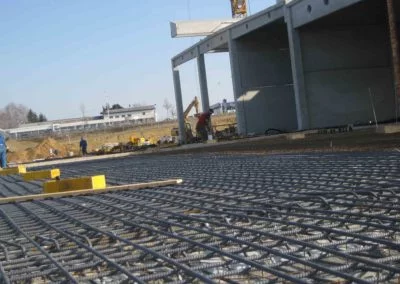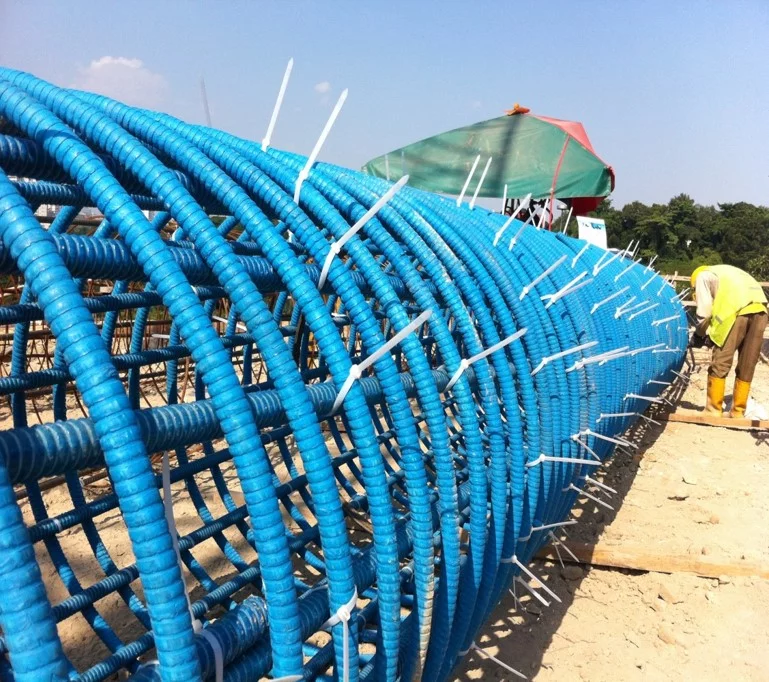Glass fiber reinforced (GFRP) rebar can replace steel rebars in concrete structures. The use can be temporary – or permanent where there is a requirement for high strength, risk of corrosion or to avoid or to avoid induction of currents from electromagnetic fields.
The product offers environment friendly solutions and provides significant reduction of repair and maintenance cost.
The glass fiber reinforced rebars are produced with pultrusion in a continuous process. Fibers used are high quality glass, resin from polyester or vinyl ester with a typical fiber content of 75%.
The GFRP rebars have two times strength (tensile strength) compared to steel. The rebar material exhibits linear-elastic behaviour up to failure – so-called brittle behaviour. The weight is a ¼ compared to steel rebars.
GFRP rebars are available in nominal diameters from 8 mm to 38 mm. Angles / bends are available in various designs such as 2D or 3D shapes, similar to that of steel rebar.
Advantages and Properties
-
low thermal conductivity reduces cold bridge through concrete
-
not electrically conductive – will not lead unwanted electrical current in case of accident
-
non-magnetic – does not interfere with electronic instruments
-
corrosion resistant – reduces the cover for corrosion protection
-
high tensile strength – approx. double the strength of steel bar
-
continuously profiled surface – proper bonding to the concrete
-
low weight – easy handling at site
| Unit | S | P | |
| Fiber | glass | glass | |
| Resin | polyester | vinyl Ester | |
| Application | temporary | permanent | |
| Color code | blue | gray | |
| Tensile strenght | MPa | 1,000 | 1,000 |
| E-Module | GPa | 50 | 60 |
| Specific gravity | g/cm³ | 2,1 | 2,1 |
| Diameter | mm | 8-38 | 8-38 |
| Breakage extension | 2.1 | 2.1 | 2.1 |
The FRP rebar has been through extensive testing at Sherbrooke University in Canada, a world-leading institute for GFRP rebar research in construction industry. Based on test results, the product is qualified as a permanent reinforcement in concrete structures.
Reference standards
– ACI 440.1R-15 – Guide for the Design and Construction of Structural Concrete Reinforced with Fiber-Reinforced Polymer (FRP) Bars.
Design Considerations
The mechanical properties of FRP reinforcing bars differ from those of conventional steel rebar in number of areas. As a result, several issues arise in the development of a design methodology for concrete structures reinforced with such bars.
The general design recommendations for flexural concrete elements reinforced with FRP reinforcing bars are presented in ACI 440.1R-06 (2006), Guide for the Design and Construction of Structural Concrete Reinforced with FRP Bars, as reported by the American Concrete institute (ACl) committee 440.
Applications
- Exposed structures
- Façade panels
- Refurbishment and strengthening
- Infrastructural buildings
- Motorways
- Highspeed tracks
- Precast concrete
- Tunnel segments
- Mining
- Dams
Applications
- Transformer stations
- Shaft rings
- Waterway engineering
- Temporary application (Soft Eye)
- Railways/ aprons using induction loops
- Research facilities
- Foundations
- Industrial Plants
- Balcony connections
- Pavements









